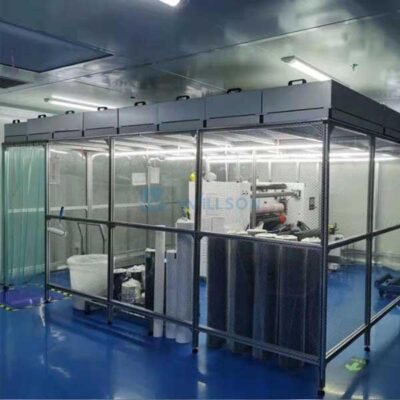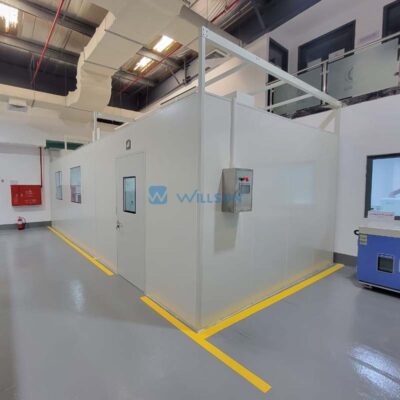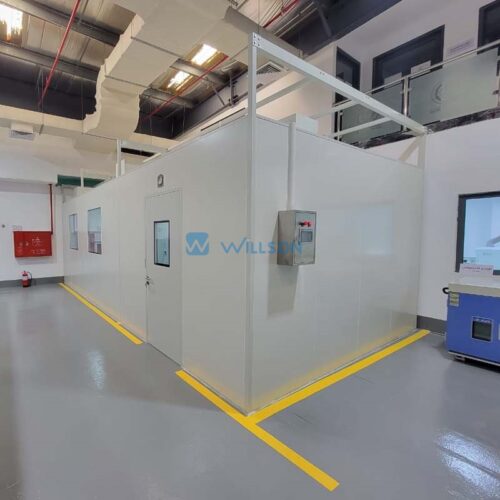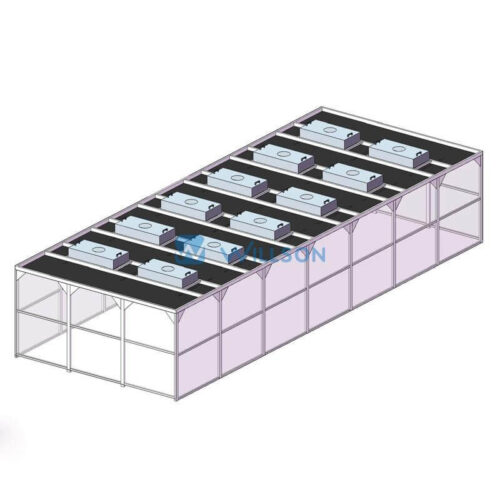Soft-wall Cleanroom and Hard-wall Cleanroom
Cleanrooms are essential environments in various industries, including pharmaceuticals, biotechnology, food, medical device, healthcare, electronics, etc. where maintaining a controlled level of cleanliness, temperature and humidity is critical. When it comes to cleanroom design, two main options are soft wall cleanroom and hard wall cleanroom. Each type has its own set of differences, advantages, and disadvantages.
Soft-wall Cleanroom V.S Hard-wall Cleanroom
Structure Difference.
Soft wall cleanrooms, also known as clean booths, are constructed using flexible materials such as anti-static PVC films or curtains. These films or curtains are typically fixed or hung from a metal frame to create the cleanroom enclosure. On the other hand, hard wall cleanrooms are constructed using rigid material such as pre-painted steel sandwich panels or anti-static arcylic plates (ESD type is optional) to form the walls and ceilings of the cleanroom.
Construction and Installation Difference
One of the key differences between soft wall and hard wall cleanrooms lies in their construction and installation. Soft wall cleanrooms are relatively quick and easy to install compared to hard wall cleanrooms, making them a cost-effective option for temporary or rapidly deployable cleanroom needs. In contrast, hard wall cleanrooms require more time and effort for construction and installation, but they offer a more permanent and durable solution.
Functional Complexity Difference
Another key difference between soft wall and hard wall cleanrooms is that soft-wall cleanroom controls air cleanliness class (ISO 5/6/7/8) only, so, to attain this aim, a soft-wall cleanroom is equipped with fan filter units only to purify the air; hard-wall cleanrooms can control not only air cleanliness class (ISO 5/6/7/8), but also temperature, differential pressure and humidity. Comparatively, soft-wall cleanroom is more like a simple product, hard-wall cleanroom is more complicated and is a systematic project. Hard-wall cleanrooms are normally equipped with FFUs and air conditioner (for small-size project with low air cleanliness class like ISO 7/8), air handling unit(AHUs), air duct, supply air, return air, exhaust air, steel doors, double-glazed windows, floor, etc.
Application Environment Difference
Soft-wall cleanroom is normally installed within a bigger hard-wall cleanroom or clean zone where the temperate or/and humidity is/are controlled, and the air cleanliness class is lower than soft-wall cleanroom. In other words, the soft-wall cleanroom is only for achieving a localized cleaner environment. For example, the bigger hard-wall cleanroom is of ISO-7 or 8 air cleanliness class, in which the soft-wall cleanroom will be of ISO-5 or 6 air cleanliness class.
Different from soft-wall cleanroom, hard-wall cleanroom can be installed within indoor, exposed directly to normal indoor environment. Hard-wall cleanroom can be designed to fit for different on-site indoor environments (here please find our three modes of hard-wall cleanrooms for your case)
Advantages and Disadvantages
In terms of advantages, soft wall cleanrooms provide flexibility in terms of layout and size. They can be easily reconfigured or expanded to accommodate changing production needs. Additionally, the flexible nature of the materials used in soft wall cleanrooms makes them easier to clean and maintain. On the other hand, hard wall cleanrooms offer superior durability and structural stability, making them suitable for long-term use in facilities where a permanent cleanroom solution is required.
However, each type of cleanroom also has its own set of disadvantages. Soft wall cleanrooms may not provide the same level of environmental control and containment as hard wall cleanrooms, especially in terms of air leakage and pressure differentials. As mentioned above, soft-wall cleanroom control air cleanliness class only (ISO-5/6/7/8). Hard wall cleanrooms, while offering superior structural integrity, may be less adaptable to changes in production processes and facility layouts.
In conclusion, the choice between soft wall cleanrooms and hard wall cleanrooms depends on specific requirements such as budget, flexibility, durability, and environmental control. Soft wall cleanrooms are ideal for temporary or rapidly deployable cleanroom needs, offering flexibility and cost-effectiveness. On the other hand, hard wall cleanrooms are well-suited for long-term use in facilities that require a permanent and robust cleanroom solution. Ultimately, both types of cleanrooms play a crucial role in maintaining controlled environments for various industries.




